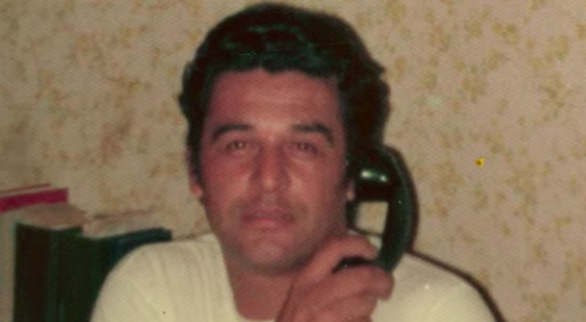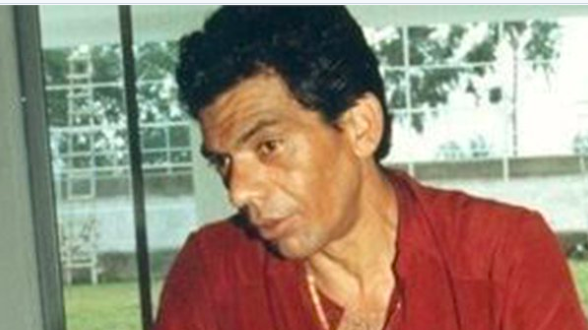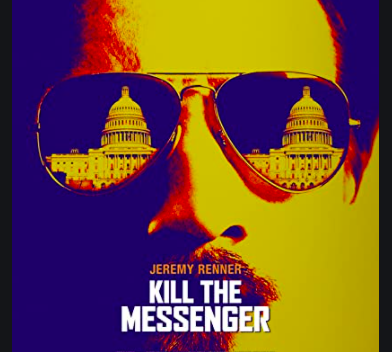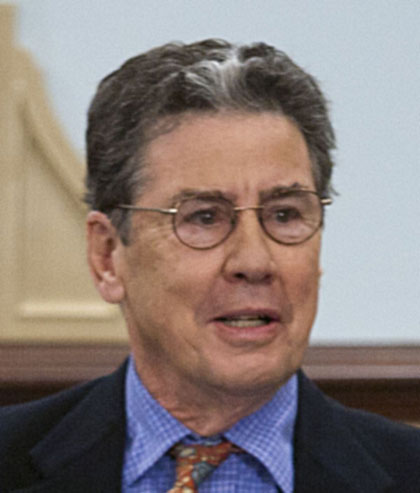
slain in Mexico in 1985 (Credit: Amazon Studios)
Former Newsweek correspondent and best-selling author Elaine Shannon tries but doesn’t quite succeed in taking down Amazon’s series “The Last Narc.”
In an extended take out for SpyTalk, Shannon quotes an impressive series of former U.S. officials who scoff at the premise of the series. But neither she nor her sources mention the story of a drug kingpin whose career lends credence to the series’ bold claims.
The four-part docudrama series focuses on one of the most sensational incidents in the so-called War on Drugs: the 1985 kidnapping, torture, and execution of DEA agent Enrique (“Kiki”) Camarena by Mexican drug lords. The series claims that Camarena was killed because of what he learned about drug traffickers protected by the CIA.
Shannon knows the Camarena case. She wrote a best-selling book, Desperados, about it. She presses the series’ creator, former DEA agent Hector Berrellez, for corroboration of the series’ premise. The answers she gets back are not terribly convincing.
Berrellez claims, without hard substantiation, that a retired CIA officer, Felix Rodriguez (a Cuban-American famed for his roles in the Bay of Pigs, the Vietnam War and the CIA’s covert war in Nicaragua) had Camarena tortured and executed to protect an agency drug-running scheme that was financing the Nicaraguan Contras, the anti-Communist jungle fighters supported by the Ronald Reagan White House. Berrellez says he has learned, from cartel bodyguards-turned-informants whom he recruited and paid that “Felix Rodriguez…interrogated Kiki Camarena and was there at the scene where Kiki was killed,” and that unnamed officials at DEA headquarters forced him to keep silent—committing multiple felonies, if true.
Three current or former DEA agents who debriefed the informants in the early 1990s, when the investigation was active, say the snitches never mentioned Rodriguez, or “Max Gomez,” his cover name, or a Cuban, or the CIA or the Contras.
Without access to those transcripts, this claim cannot be verified.
Rodriguez denies he was in Guadalajara at the time. To take Rodriquez’s denials at face value would be naive. Rodriguez is known to have worked with drug traffickers in advancing the contra’s cause. In his memoir, he boasts about murdering men he suspected of being communist spies. He cannot be considered a trustworthy source.
All of Shannon’s named sources in the DEA insist Camarena’s murder was not related to drug trafficking by U.S.-backed contras in Central America.
“The Intel community helped in providing information,” former DEA administrator John Lawn told Shannon. “but at no time did the investigation take us to Nicaragua, or to the Contras. The fanciful narrative outlined in The Last Narc makes interesting viewing but is without historic merit.”
However, neither Lawn nor any of Shannon’s other sources said anything about a man named Juan Ballesteros Matta. He was a convicted Honduran trafficker, known for supporting the contras. Matta was also implicated in Camarena’s murder. With no mention of Matta, Shannon’s conclusions about The Last Narc cannot be considered definitive.

Who Is Juan Matta Ballesteros?
Born into poverty in Honduras, Matta emigrated to the United States as a young man. Without documentation, he was deported. He returned and was arrested on drug charges. He served three years in a Florida prison, then returned to the drug business in Mexico, where he rose to become a leading figure in a drug trafficking syndicate working with the Medellin cartel in Colombia.
One of Matt’s front companies, SETCO Aviation, served as the principal air transport frim supportng the contra rebels in their battle against the leftist government of NIcaragua in 1985-86. (I first wrote about the CIA and the contras in The New Republic in August 1985.)
According to a 1987 Senate investigation headed by Sen. John Kerry, the DEA had information that
Matta was a major figure in the Colombian cartel and was involved in the murder of DEA agent Enrique Camarena. Matta was extradited to the United States in 1988 and convicted on drug trafficking charges.
Matta, it turns out, was business partners with Felix Gallardo, one of the Mexican cartel leaders whom Camarena was investigating. The DEA agent tracked Matta to Colombia where he had been arrested. Matta escaped from jail via bribery in 1983 and returned to his native Honduras, where he resumed trafficking on a breathtaking scale. DEA says Matta organized the transshipment of 5,000 kilos of cocaine into the United States.
In February 1985, Camarena was kidnapped in Guadalajara, tortured and killed. At the time, Matta was creating SETCO, cultivating contacts with the contras, and going into business with the U.S. government. For a year, Matta shipped arms to the contras and cocaine to the United States, while receiving $189,924 in U.S. taypayer funds.
For the well-connected trafficker, the arrangement was convenient, lucrative and safe. For the hundreds of thousands of crack cocaine users consuming Matta’s product, the results were addictive, devastating, and dangerous.
DEA Denials
John Lawn’s denials are technically accurate. The DEA did not investigate Matta’s services to the contras in Nicaragua–because the CIA didn’t disclose what it knew. Lawn’s claim that “the intel community helped” his probe may be true in some respects but it obscures the fact that the CIA also played the DEA for fools.
Not surprisingly, Lawn is loathe to publicly acknowledge the possibility he was duped by another U.S. agency. He may also be restricted in what he can say because of secrecy oaths and CIA classification procedures.
In 1988 Matta was arrested by U.S and Honduran officials and sent to the United States to face charges of running a trafficking organization and killing Camarena. In 1990 Matta was convicted of trafficking and conspiring to kidnap Camarena but acquitted on the charge of murdering him.
Leave aside the question of the validty of the “The Last Narc” scenario for a moment.
The plain fact is that Matta’s business, SETCO, delivered arms to the contras at the same time Matta was trafficking huge quantities of cocaine into the United States. He acted under the nose of the CIA, all while doing business with the Mexican cartel leader who allegedly tortured Camarena to death.
This context is missing from Shannon’s piece, which means two key questions go unanswered.
Key Questions
Was Matta protected by the U.S. government at the time of Camarena’s murder?
Shannon doesn’t offer an opinion. CIA Inspector General HItz said yes.
When the Justice Department asked the Agency in April 1989 what it knew about Matta, the agency offered up a deliberate lie.
The CIA claimed to have made an “extensive search of the files and indices of the Directorate of Operations. . . . There are no records of a SETCO Air.” In fact, as one CIA employee told Hitz, “it was common knowledge [inside the Agency] that the company was used to support the Contra program.”
Was Matta Involved in Camarena’s death?
At Matta’s trial, a fiber analyst testified that a sample of Matta’s hair matched hairs found in the Guadalajara house where Camarena was tortured. The jury wasn’t convinced and acquitted Matta on the charge of murdering a federal agent. In 2018, the Justice Department dropped the kidnapping and murder charges against Matta, citing the weakness of the fiber analysis testimony. Matta remains in a U.S. prison serving a life term for racketeering.
Shannon doesn’t deal with the Kerry Report’s allegations about Matta, which is its biggest weakness. The DEA’s linkage of a U.S.-backed trafficker to Camarena’s murder is a matter of public record, not Hollywood mythmaking.
That linkage doesn’t prove “Last Narc’s” claim that Camarena was going to denounce the CIA for coddling traffickers. But the fact that one of Camarena’s investigatory targets, Matta, was servicing the needs the CIA-backed contras at the time of Camarena’s murder is indisputable.
Dark Alliance

Shannon deals only briefly with the larger issue of collaboration between CIA, the contras and drug traffickers. What little she does have to say is not entirely accurate.
Shannon describes the Last Narc scenario as
a Mexicanized twist on a 1996 series, Dark Alliance by San Jose Mercury News reporter Gary Webb, who committed suicide after his work was discredited.
To say Webb’s work was “discredited” ignores the fact his thesis about a CIA-contra drug connection in 1996 would be amply confirmed by the 1998 Hitz report.
As a reporter for the San Jose Mercury News, Webb uncovered the story of how Ricky Ross, a major street trafficker in Los Angeles, relied on two Nicaraguan drug traffickers for multi-hundred kiloton shipments of cocaine. These traffickers received favorable treatment in California court by citing their “national security” work with the CIA. At the same time, addiction to smokable “crack” cocaine was ravaging South Central Los Angeles.
In the Dark Alliance series Webb linked the CIA’s wilingness to do business with multi-kiloton traffickers with the reality of the cocaine glut on the streets of America. Carefully stated, Webb’s thesis was bold but factually accurate: the CIA’s willingness to business with drug traffickers material contributed to the crack cocaine epidemic in Los Angeles.
[Webb’s story is well-told in a taut 2014 movie, “Kill the Messenger,” starring Jeremy Renner.]
The CIA and its defenders in the Washington press corps pounced on some overstatements in Webb’s articles to misrepresent his larger point. “The spy agency didn’t deal in drugs,” Shannon writes. Since Webb never asserted the CIA sold drugs, this supposedly exculpatory talking point is actually meaningless.
Because of the public furor that Webb’s reporting raised in the black community, CIA had to investigate. Inspector General Hitz then reviewed all of the agency’s contacts with suspected drug traffickers in the 1980s. Hitz wrote up his findings in a mammoth report that few reporters bothered to read.
In October 1998, the CIA issued a press release, which concluded
“no information has been found to indicate that CIA as an organization or its employees conspired with, or assisted, Contra-related organizations or individuals in drug trafficking to raise funds for the Contras or for any other purpose.”
That sounds like a blanket denial. It is actually full of holes.
If you read the entire Hitz Report, you will find ample confirmation of the holes. Hitz stated that the CIA wittingly did business with at least six drug trafficking organizations, and dozens of suspected traffickers, in the 1980s–and rarely breathed a word of what it knew to the DEA.
Juan Ballesteros Matta, whom the DEA believed was involved in Camarena’s murder, was just one example of a larger phenomneon.
So how can the CIA say it never “conspired with or assisted” drug traffickers?
You have to think like a CIA official. The agency, technically speaking, did not “conspire with or assist” SETCO in the smuggling of drugs or raising money for the contras. The agency merely hired SETCO for contra resupply operations. The CIA didn’t “assist” Matta. Matta assisted the CIA. Therefore, Langley said, the agency was innocent of wrongdoing.
This is the cover story that credulous reporters accepted as truth.
CIA Favored Traffickers
Then there was DIACSA, a front company used to purchase aircraft for the contras. DIACSA was controlled by Alberto Caballero, and six other persons later convicted for bringing 900 pounds of cocaine into the United States.
Hitz stated the that CIA was well-informed about Caballero at the time he was receiving U.S. taxpayer funds.
A May 4, 1985 cable to Headquarters provided a summary of reporting concerning FRS personnel who may have been involved in drug trafficking. According to the cable, Caballero in February 1985 had offered to transport FRS supplies to Ilopango or Costa Rica in one of his aircraft if he could make the landing arrangements. The cable also reported that Caballero was the Miami representative of a company based in San Jose that was owned by David Mayorga. The cable noted that there were those who believed that Mayorga, Caballero and others were transporting drugs from San Jose to Miami.

Did CIA tell the DEA or anyone in the U.S. government about those suspicions?
The CIA inspector general said no. He stated:
“No information has been found to indicate that the Agency provided any information concerning alleged drug trafficking by Caballero or DIACSA to other U.S. Government intelligence or law enforcement agencies or the Congress.”
Hitz’s findings were much the same for the other four front companies controlled by traffickers. The CIA had received credible intelligence reports about their involvement in the cocaine trade. The agency did nothing to prevent them from receiving U.S. taxpayers dollars. All while the country was suffering from an epidemic of cocaine use.
Shannon knows this reality. She has read the Hitz report, but doesn’t think it relevant the Camarena story. She describes Hitz’s findings as “allegations, ” when in fact they were conclusory judgments of a senior U.S. government fact-finder.
She summarizes the Hitz report in a single sentence that is accurate in its details and generous to the CIA in its brevity.
Even the CIA’s internal watchdog concluded that, while the spy agency didn’t deal in drugs, it ignored hundreds of allegations contained in nearly a thousand cables that Contra officers, contractors and supporters engaged trafficking.
That was the milieu in which Camarena investigated Matta and the Guadalajara cartel. The CIA was not on his side.
Conclusion
“No convincing evidence exists that Camarena was murdered because he knew too much,” Shannon writes, “”much less that he was about to blow the whistle on [the CIA].”
But legitimate questions remain. If Camarena wasn’t killed because he knew too much, why was he killed? What did Camarena know about SETCO and Matta’s support for the contras?
I’m watching The Last Narc for answer.s. I’ve asked Shannon for her comment which I will report in another story.
So whenever I hear somebody say the CIA-contra drug connection is a “conspiracy theory,” I tell them to read the Hitz Report,, just flip to page 800 and start reading. The facts are all there, no theory necessary.
Source: TV Spies: Amazon’s Wacky CIA Drug War Conspiracy Flick Draws Qanon Raves – SpyTalk


